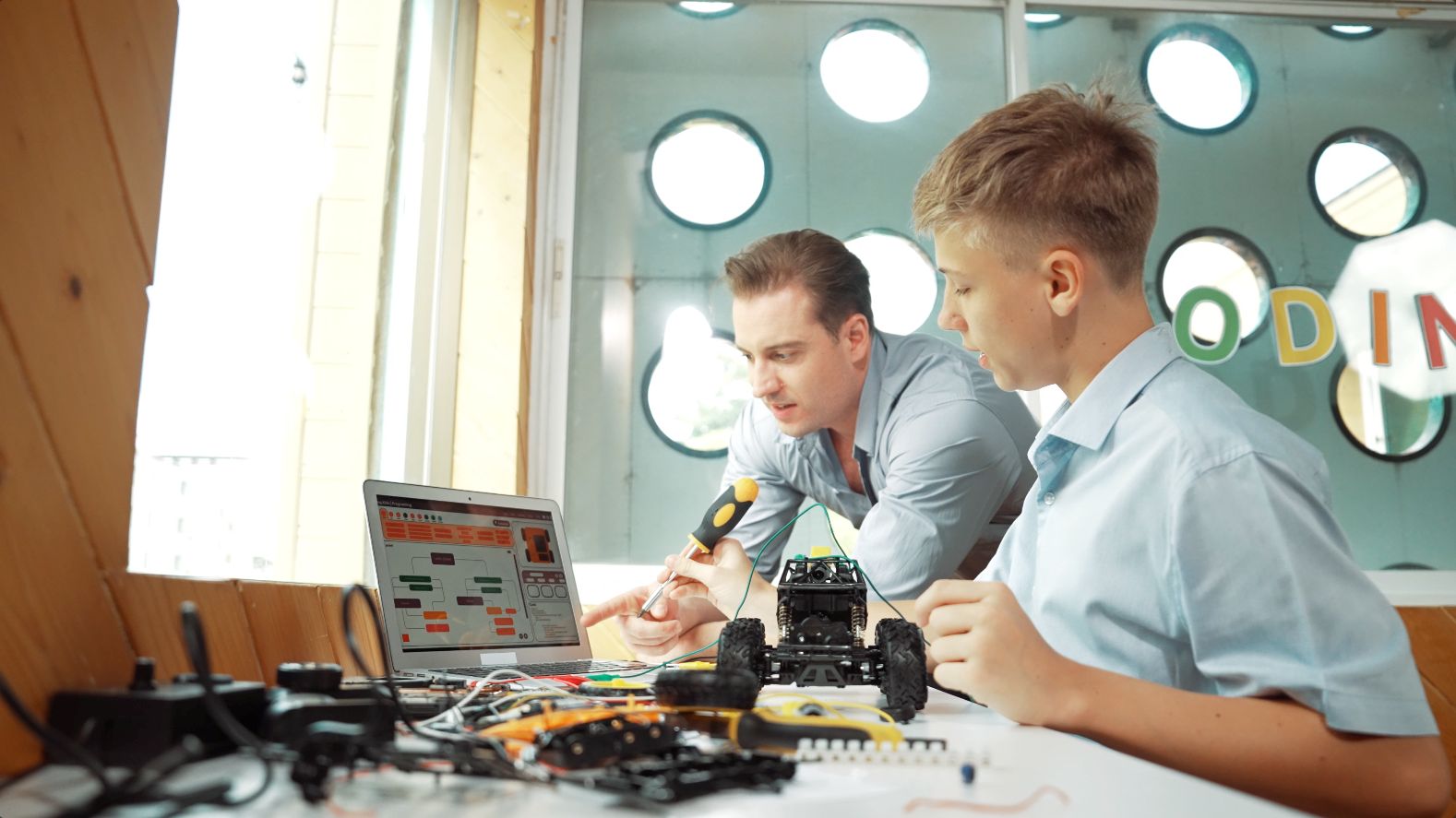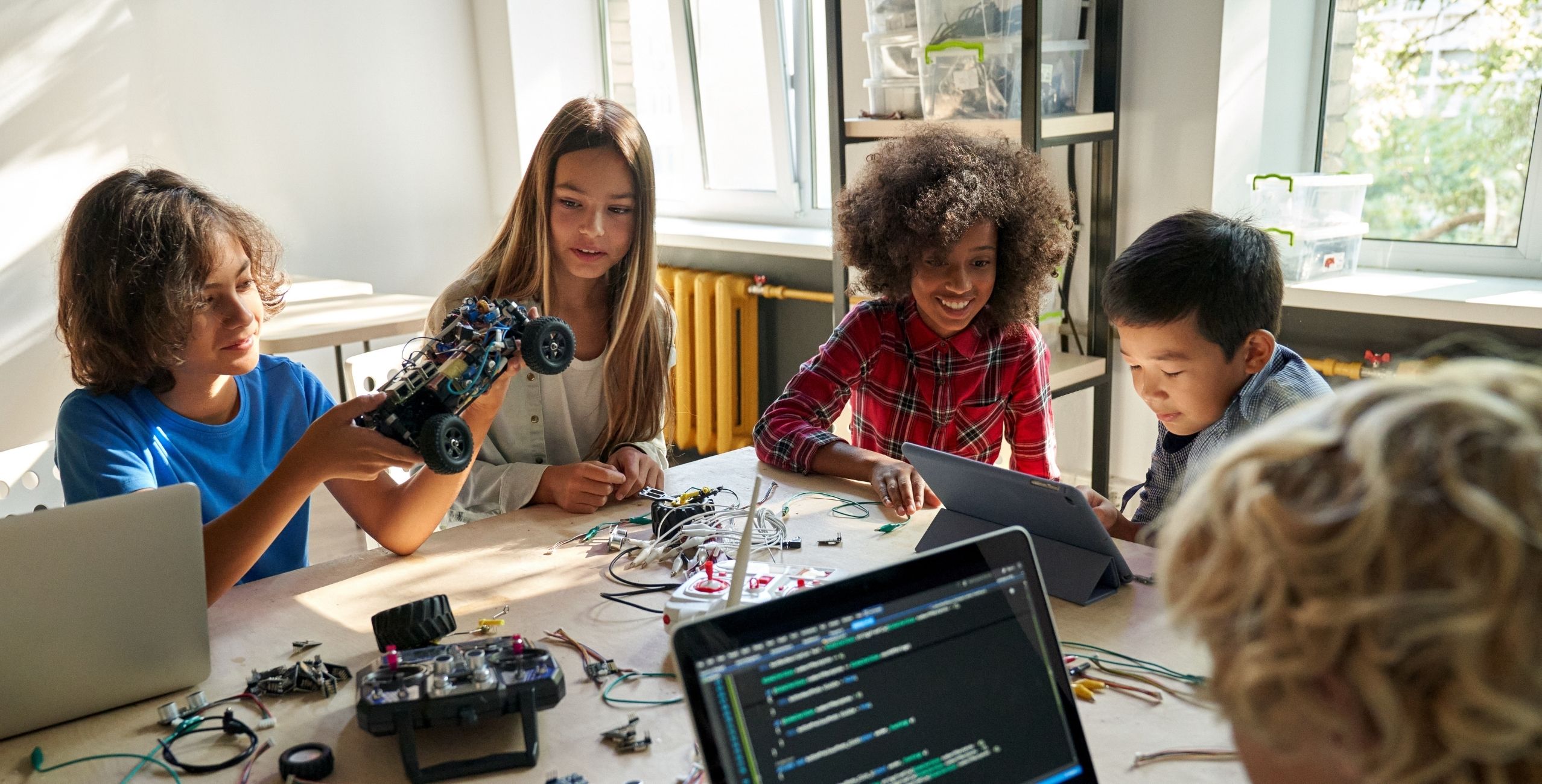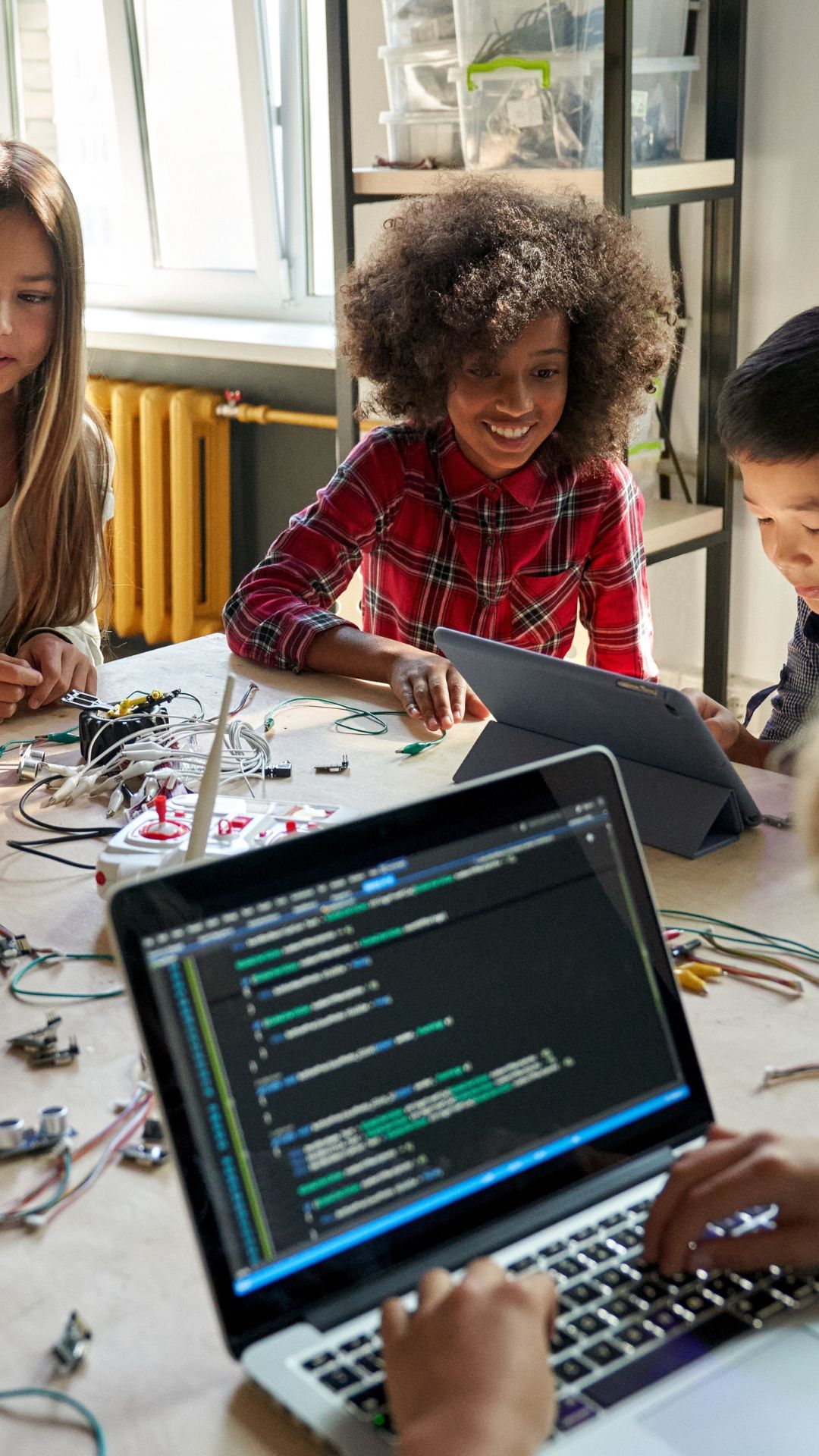

Goals
What We Aim to Build
To understand how learning works at Forge, you have to start with our goals.
We exist to develop the traits that matter most in the world ahead:
Originality
Students think for themselves and build what’s missing.
Adaptability
They thrive amid uncertainty and change.
Ownership
They take responsibility for results, not just effort.
Resilience
They persist when work gets hard.
Every decision, project, and conversation at Forge is designed to strengthen these four outcomes - so students leave ready not just to keep up with the world, but to shape it


Capabilities
Two Types of Skills. One System for Mastery.
The skills are our path to the goals.Every Forge student develops two interconnected sets of abilities that define how they think, learn, and perform.
Academic Skills - What Students Know
Aligned with New Jersey Learning Standards and the Next Generation Science Standards (NGSS)*, students master core academics through real projects. Progress is based on mastery, not seat time.
Power Skills - How Students Think and Act
The human capabilities that make learning stick and leadership possible. Built through feedback, iteration, and reflection in every challenge.
Together, 13 skills and 68 sub-competencies form the foundation of the Forge Proof Transcript – a living record of what students can actually do.
Accelerated Mastery
We believe our curriculum, paired with our year-round calendar, will put Forge students two to three years ahead of grade-level standards within four years.
Continuous learning means no back-slide, no wasted time, and steady momentum.
Challenge Model
Learning by Building, Not Memorizing
Students don’t study disconnected subjects. They engage in challenges – authentic, integrated problems that connect learning to the real world.
Every challenge is designed for:
Relevance
It matters to students’ lives or communities.
Impact
It leads to something that is put out into their community or the world.
Agency
Students make real decisions about what to learn and how to demonstrate it.
Challenges are co-created with students based on their interests, aptitudes, and developmental needs. They are never one-size-fits-all.
Every student is paired with a Guide – a personal coach who helps them on these Challenges and more importantly, stays with them for multiple years.
Guides help students set goals, track mastery, and reflect on growth. They’re part teacher, part mentor, part strategist – someone who knows your child deeply and helps them become their best self.
Learn more about how our one-on-one coaching model builds lasting confidence and direction. →
Studios
Where Learning Happens
Forge students don't sit in rows & columns listening to lectures. They work on Challenges in studios built for creation, collaboration, and doing real work.
Each studio is a professional environment where knowledge turns into action:
Bio-Innovation Lab
Experiment with living systems, design bio-solutions, and explore how science meets entrepreneurship.
Media Lab
Write, film, and produce stories that persuade, inform, and inspire.
Electronics & Robotics Lab
Build machines, wire circuits, and prototype real-world technology.
Digital Fabrication Studio
Combine architecture, product design, and fabrication. Sketch, 3D model, and construct functional objects and environments.
Sports Science Lab
Analyze motion, test performance, and study how the body achieves its best.
Studios replace passive classrooms with active workshops. Every space is designed to make thinking visible and learning tangible.


How It Works
How a Challenge Works
Each challenge follows a three-part rhythm rooted in developmental science to turn experience into understanding...
1. Preparation: Build the Foundation
Students begin each challenge with focused seminars and workshops that give them the core knowledge and tools they’ll need. Guides introduce key ideas, models, and frameworks - just enough structure to spark curiosity and confidence.
2. Exploration: Test and Apply
Next, students dive in. They investigate, prototype, debate, and gather data to make sense of what they’ve learned. Exploration is where understanding takes shape through action, reflection, and iteration.
3. Production: Create and Show Mastery
Every challenge ends with creation. Students produce something original - a product, business, experiment, or presentation - that demonstrates mastery and impact. It’s both assessment and accomplishment, proof of what they can do.
This process builds deep applied learning because students connect knowledge to action.
Challenges
What Challenges Look Like
Challenges are architected with a focus on relevance, impact, and agency. Sample Challenges given below along with the Academic and Power Skills they foster.
Develop a Public Health Campaign
Pick a health issue that matters to you, your family, your peers or your community (like asthma, diabetes, poor sleep, obesity). Learn how it works, what causes it, and what people can do to prevent or manage it. Along the way, you’ll interview doctors, scientists, researchers and entrepreneurs from the Forge Guild who study and solve for these problems every day.
You’ll use what you learn to create a campaign that helps others understand the issue and make better choices. You might film in the Media Lab, test ideas in the Sports Science or Bio-Innovation Lab, or design materials in the Digital Fabrication Lab.
Why It Matters
This is a great opportunity use science and storytelling to help people. You’ll see how biology, data, and design come together to make a real difference in people’s lives.
Outcome
You’ll share your campaign with scientists, Guild mentors, and the community we live in. It could be a short video, a podcast, a children’s book, a musical or anything you dream up. What matters is that your work helps others understand and act.
Labs You Might Use
Bio-Innovation Lab: Explore how diseases work and what prevention looks like.
Sports Science Lab: Understand the body and how various actions can help.
Media Lab: Film interviews or produce digital stories.
Digital Fabrication Lab: Create visuals, posters, or models for your campaign.
This challenge turns scientific study into public purpose. Students move from learning about biology and health to using that knowledge to educate and motivate others.
Why This Works
- Relevance: Students choose issues that affect them and their world, making learning personally meaningful.
- Impact: They produce real campaigns that inform others and are reviewed by Guild scientists and community partners.
- Agency: Students make creative and strategic choices from what issue to study, how to present it, and which audience to reach.
Developmental Fit
Middle schoolers are beginning to connect cause and effect, both scientifically and socially. This challenge channels that curiosity into evidence-based thinking, empathy, and public communication.
Forge Skills Developed
Academic Skills
Power Skills
Business Detective (Middle School)
Ever wondered why some local businesses thrive while others struggle? In this challenge, you’ll become a business detective. Pick a nearby store, restaurant or service that you like and figure out how it really works, i.e., where the money comes from, what it costs to run, and what could make it stronger. You’ll interview the owner and talk with Guild entrepreneurs and investors who’ve built companies of their own.
You’ll build a simple financial model to show what’s working and what could improve, then share your insights. You’ll film interviews with the business owner and some of their customers in the Media Lab. You might design branding materials in the Digital Fabrication Lab.
Why It Matters
You'll see what it takes to make something succeed and how math, communication, and creativity connect in the real world. This isn't a school project; it's a real investigation that can help a business do better.
Outcome
You'll present your finding to the business owner and Guild mentors. Your project might include a short report, a spreadsheet showing how the business makes money, or a presentation wit your improvement ideas.
Labs You Might Use
Media Lab: Record interviews and create your final presentation.
Digital Fabrication Lab: Design signage, prototypes, or marketing materials.
This challenge connects academic learning with economic and entrepreneurial thinking. Students apply math, writing, and communications to real business problems seeing directly how these skills create value.
Why This Works
- Relevance: Students analyze businesses they already know and like, i.e., restaurants, stores, or services they visit, so learning feels real.
- Impact: Their findings and ideas can genuinely help local owners.
- Agency: They choose the business, design their analysis, and decide how to share what they’ve learned.
Developmental Fit
Early adolescents are ready to move from abstract math to applied reasoning. This challenge builds confidence, numeracy, systems thinking and an understanding of how decisions shape outcomes in the real world.
Forge Skills Developed
Academic Skills
Power Skills
From Idea to Ordinance
What if you could change something in your town? In this challenge, you’ll learn how laws are made and how people like you can influence them. You’ll start by finding a local issue that matters to you: a safety concern, an environmental need, or something that would make your community better.
You’ll research how similar issues have been handled in history, study how local government works, and interview people who make decisions including council members, planners, and policy experts from the Forge Guild. Then you’ll create and present a proposal for a new policy or ordinance that could realistically be passed.
You might design solutions to the problem in the Digital Fabrication Lab, record interviews or campaign videos in the Media Lab, or prototype ideas in the Electronics Lab to make your ideas come to life.
Why It Matters
You’ll see how real change happens. You’ll learn to connect the past with the present and understand why some ideas succeed while others stall. You’ll experience what it means to use your voice to make a difference.
Outcome
You’ll present your proposed law or ordinance to local officials and community members. Your project could include a written proposal, visual campaign, or public presentation backed by evidence and history.
Labs You Might Use
Media Lab: Record interviews or make a campaign video explaining your proposal.
Digital Fabrication Lab: Design infographics, signage, or model spaces affected by your idea.
This challenge helps students understand how civic systems work and how citizens can shape them. It combines research, history, communication, and design thinking in a project with visible real-world relevance.
Why This Works
- Relevance: Students work on problems that affect their daily environment, giving purpose to learning about history and government.
- Impact: They see how informed citizens turn ideas into policy and how their own voices can create change.
- Agency: Students choose their issue, design their campaign, and take ownership of presenting their solution to real audiences.
Developmental Fit
In early adolescence, students are forming ideas about fairness, rules, and leadership. This challenge channels that emerging sense of justice into structured civic reasoning, communication, and historical analysis helping them see themselves as active participants in shaping their world.
Forge Skills Developed
Academic Skills
Power Skills
Each challenge connects knowledge to consequence, and each ends with something real to show.
Daily Rhythm
How a Forge Day Flows
Forge days are built for focus, independence, and movement - not bells or busywork. No two days are identical, but each follows a rhythm of action and reflection.
Morning
Standup with your Guide and peers. Short challenge seminars. Fitness and movement to activate focus.
Midday
One-on-one coaching. Deep reading or analysis windows. Lunch that builds community, not noise.
Afternoon
Studio time with peers to build, test, and collaborate. Real work, real feedback, real progress. Fitness and movement breaks as needed.
End of Day
Reflection and next-day planning. Progress is personal. Mastery sets the pace, not the curriculum.
Weekly Rituals That Build Character
What Did You Make Happen?
Fridays are for proof. Students show what they built, learned, or achieved. Every week ends with results, not promises.
What Risks Did You Take?
Growth requires courage. Students share where they stretched themselves and what they learned by stepping out of their comfort zone. Risk-taking should become second nature.
Accountability Cards
Each Monday, students commit clear goals to a peer they’re working with. Each Friday, they review outcomes. Reflection, risk, and follow-through become habit. These rituals make progress visible, self-management second nature, and create community.
Proof Transcript
Proof of Capability, Going Beyond Grades
At Forge, progress is captured through the Forge Proof Transcript.
Placeholder for Transcript Example
It shows:
Mastery in academic and power skills. Links to real work, portfolios, and reflections. Feedback from guides and mentors. Evidence of impact - ventures launched, research completed, products built.
The result: proof of capability. Incredibly powerful for college applications, internships, scholarships, leadership opportunities, raising funding and more. Most of all, it is a reminder to students of what they're capable of and to keep increasing their ambition and impact.


Be first to join a school built for the future
Give your child a head start – inside a community of forward-thinking families.
Join our Founding Families list for early access to admissions, events, and private previews.